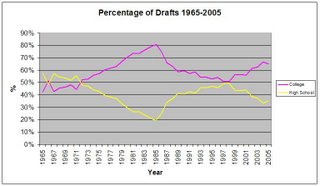Scoring my first of four consecutive games tonight at Coors Field as the Rockies take on the Padres. For the Rockies this is an extremely important series and they've responded by winning the first two games; on Thursday night with a 6 run comeback to win 9-8 and last night winning 3-1 on some fine pitching by Byung-Hyun Kim. Coming into tonight they were just 4.5 games in back of the Padres.
Tonight they lost 4-2. A costly error by Garrett Atkins led to 2 runs for the Padres in the top of the 5th that ended up being the difference.
But what interested me thus far was the situation that occurred in the bottom of the third inning. After Jeff Francis grounded out to third, Jamey Carroll slapped a single to right. With Clint Barmes up he stole second base despite a nice throw by Mike Piazza. So at this point Carroll is on second with one out. Early in the at bat Barmes actually acted as if he were going to bunt but continued to foul off pitches to work the count to 2 and 2. At this point he hits a lazy fly ball that Mike Cameron in center drifts under. Carroll tags at second and makes it easily to third. What surprised me was the reaction of the crowd of more than 43,000 to this sequence of events. They erupted in applause almost as if Barmes had driven in the run.
There are two possible explanations for this. The first is that perhaps the expectations for a Barmes at bat are so low that any perceived positive outcome is treated as a victory. I myself am of that persuasion. However, I'm inclined to think that the real reason is a fundamental misunderstanding regarding probability and the importance of outs. With one out and a man on second the run expectancy over the last six years, as shown in the following table, has been .704 runs.
Base/Out 0 1 2
xxx 0.530 0.287 0.112
1xx 0.921 0.552 0.242
x2x 1.160 0.704 0.335
xx3 1.441 0.978 0.371
12x 1.523 0.935 0.445
1x3 1.844 1.214 0.510
x23 2.030 1.430 0.599
123 2.364 1.579 0.789
In other words, all other things being equal a team will score on average about seven tenths of a run in the remainder of the inning when you reach this base/out state. After Barmes flied out to center the run expectancy dropped almost in half to .371. In other words, the Rockies situation had deteriorated markedly and yet the crowd reacted as if something good had happened. Of course what they were reacting to was the fact a runner had advanced 90 feet and was therefore physically closer to home plate.
That perspective is flawed however since in reality Carroll (and subsequent hitters) were more likely to score while he was standing on second a few moments prior. The reason is that the number of outs, the quantity of which is in limited supply and therefore what actually controls the game, is all important in baseball. Fundamentally, sacrificing a base (other than home) for an out always decreases run potential. There are situations where doing so increases the probability of scoring a single run but those are few and far between and generally occur only with the weakest of hitters (pitchers) at the plate. In any case, this early in the game it is always a better bet to try and maximize run potential rather than playing for the single run, a lesson that Rockies manager Clint Hurdle should take to heart.
So this is a case where our eyes deceive us. Carroll standing on third with two outs is not better than him standing on second with one out. The structure of the game makes this the case.
Of course the fans also engaged in a spirited round of "the wave" in the 8th inning during a crucial situation with Padre runners on board.






125x125_10off+copy.jpg)


